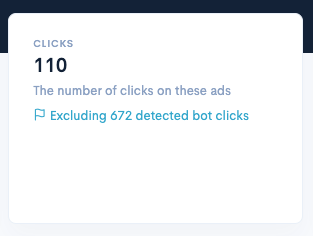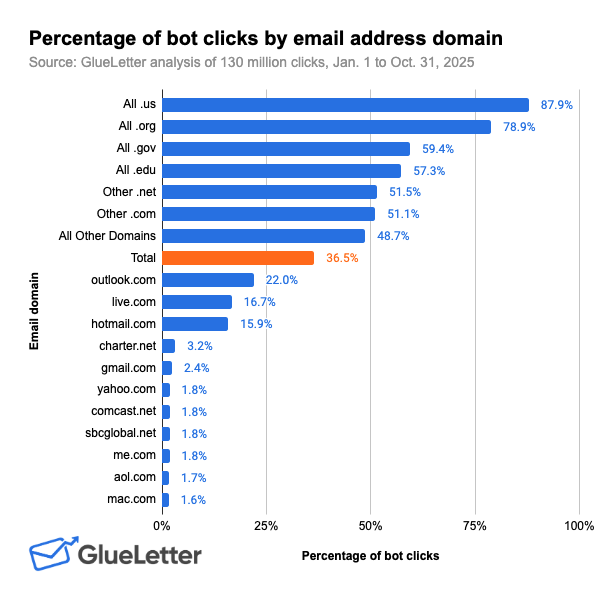More than one-third of all recorded clicks on newsletter links are not actually by humans, according to a new analysis of GlueLetter newsletter analytics data.
We analyzed more than 130 million link clicks, which were imported from dozens of diverse newsletter publishers who use a wide variety of leading ESPs. GlueLetter has its own proprietary and universal method of detecting which clicks are generated by “bots” (automated link clicks made by network security filters — not real readers). Some ESPs, such as Sailthru, also detect bot clicks in their own ways, which GlueLetter also imports. This analysis includes both detection methods.
In total, 36.5% of all newsletter click events were determined to be artificial.
This means newsletter publishers need effective methods of determining which clicks are real or not. The “bot clicks” are not evenly distributed. They tend to cluster around a few links in each email. This can wildly distort your understanding of what links were actually the most popular with readers.
Artificial clicks are also a particular pain point for publishers who sell newsletter ads. When reporting the number of ad clicks back to an advertiser, artificial clicks can cause unrealistic results and undermine credibility if not addressed.
GlueLetter solves that problem by importing email events from any Email Service Provider, and running the clicks through our own bot-filtering process. The advanced data dashboards, growth tools and scheduled reports you generate in GlueLetter show you what humans did, not bots.


Which email providers generate the most bot clicks?
While 36.5% of all clicks are by bots, this rate varies drastically by different email providers.
GlueLetter analyzed the rate of bot clicks for each type of email address domain.

Personal-use email providers like Gmail and Yahoo have very low rates of bot activity (less than 2% of clicks). Services like outlook.com and hotmail.com are a bit higher (22% and 16%, respectively) but still mostly human.
The problem of artificial clicks is much greater for any publisher who significantly reaches a professional audience (with email addresses through their employer or large institutions) or government employees. For that reason, “B2B” publishers and even “B2P” (Business-to-Professional) publishers should be especially strategic about filtering out their bot clicks.
Government-managed email systems, with email addresses ending in “.gov” or “.us”, have very high rates of bot activity. The “.us” domains (which are often for K-12 school systems and other government agencies) had the highest rate overall, with nearly 88% of clicks being flagged as artificial. The “.gov” domains saw 59% artificial clicks.
Email systems for nonprofit organizations (.org) saw the second-highest rate of artificial clicks, at 79%. And educational organizations (.edu) were also majority-artificial at 57%.
| Email domain | Percentage of bot clicks |
| All .us | 87.9% |
| All .org | 78.9% |
| All .gov | 59.4% |
| All .edu | 57.3% |
| Other .net | 51.5% |
| Other .com | 51.1% |
| All Other Domains | 48.7% |
| Total | 36.5% |
| outlook.com | 22.0% |
| live.com | 16.7% |
| hotmail.com | 15.9% |
| charter.net | 3.2% |
| gmail.com | 2.4% |
| yahoo.com | 1.8% |
| comcast.net | 1.8% |
| sbcglobal.net | 1.8% |
| me.com | 1.8% |
| aol.com | 1.7% |
| mac.com | 1.6% |
Solve the problem of bot clicks
Connect your existing ESP to GlueLetter to filter your bot clicks, and unlock loads of advanced data analysis and tools.